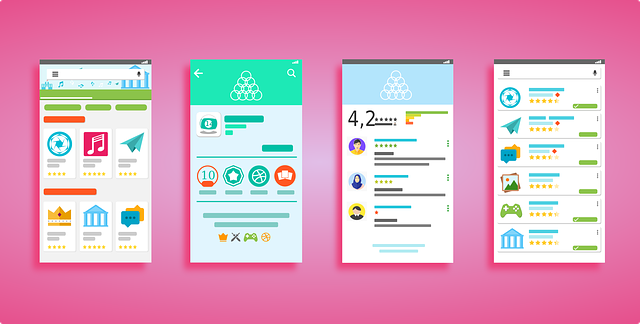User-friendly UI/UX design combines visual appeal with ease of use, driven by understanding user needs and behaviors. Key principles include simplicity, clarity, effective information architecture, and intuitive interactivity. User research, accessibility, and usability testing are vital for creating inclusive, engaging experiences that cater to diverse users and foster positive interactions, ensuring long-term satisfaction and interface relevance.
In today’s digital landscape, user-friendly UI/UX design is paramount for engaging and retaining users. A well-crafted interface not only enhances user experience but also drives conversion rates. This comprehensive guide delves into the essential elements of UI design, from understanding user needs to implementing accessibility features. By exploring simplicity, clarity, information architecture, visual hierarchy, interactive elements, and usability testing, you’ll equip yourself with best practices to create interfaces that captivate and satisfy users alike.
Understanding User-Friendly UI/UX Design: A Definition

User-friendly UI/UX design is a concept that prioritizes creating intuitive and accessible digital experiences for users. It involves understanding user needs, behaviors, and preferences to craft interfaces that are not only aesthetically pleasing but also easy to navigate and interact with. The goal is to ensure that users can accomplish their tasks efficiently and enjoyably without facing unnecessary complexities or frustration.
At its core, UI design focuses on the visual elements and layout of a digital product, ensuring consistency, simplicity, and clarity in buttons, forms, menus, and other interactive components. UX design, on the other hand, delves deeper into user interactions, addressing usability, accessibility, and overall user satisfaction. By seamlessly integrating these two disciplines, designers create intuitive interfaces that cater to users’ mental models and expectations, fostering a positive and engaging experience.
The Role of Simplicity and Clarity in UI Design

In UI design, simplicity and clarity are paramount principles that significantly enhance user experience. A clean, uncluttered interface allows users to navigate with ease, reducing cognitive load and improving efficiency. By presenting information in a straightforward manner, designers ensure that users can quickly grasp how to interact with the application or website. This minimalism does not equate to barebones design; instead, it involves carefully curating elements to prioritize functionality and aesthetics, creating a seamless and intuitive experience.
Clear visual hierarchy, consistent layouts, and concise labeling are essential components of this approach. Users should be able to focus on content and tasks without distractions, enabling them to accomplish their goals seamlessly. Simplicity in UI design not only makes applications more accessible but also fosters user trust and satisfaction, encouraging exploration and engagement.
User Research: Unlocking the Foundation of User-Centric Design

User Research plays a pivotal role in laying the foundation for user-centric UI design. By understanding the needs, behaviors, and goals of your target audience, designers can create interfaces that resonate with users on a deeper level. This involves gathering qualitative and quantitative data through various methods like interviews, surveys, usability testing, and analytics tracking. Such insights enable designers to make informed decisions about information architecture, navigation patterns, and visual aesthetics, ensuring the UI aligns perfectly with user expectations.
Effective user research translates into designing interfaces that feel intuitive and effortless to use. It means crafting user flows that guide users seamlessly through tasks, presenting content in a clear and concise manner, and incorporating feedback mechanisms for continuous improvement. Ultimately, putting users at the heart of the design process leads to creating UI designs that drive engagement, foster satisfaction, and deliver exceptional user experiences.
Information Architecture: Organizing Content for Seamless Navigation

In the realm of UI design, Information Architecture stands as a cornerstone, meticulously organizing content for seamless navigation. A well-structured IA ensures users can effortlessly find relevant information, enhancing overall usability and user satisfaction. By prioritizing hierarchical organization, intuitive labeling, and consistent formatting, designers create a logical flow that guides users through an application or website.
This structured approach involves categorizing content into meaningful groups, establishing clear relationships between pages or screens, and implementing a straightforward sitemap. Effective IA not only simplifies navigation but also empowers users to explore features independently, fostering a positive user experience in the heart of UI design.
Visual Hierarchy and Layout: Guiding Users Through the Interface

In UI design, visual hierarchy and layout play a pivotal role in guiding users through an interface. By organizing elements based on their importance and relevance, designers can create a clear path for user interaction. This involves using size, color, contrast, proximity, and alignment to draw attention to crucial components, making the user experience intuitive and seamless. For instance, placing call-to-action buttons in prominent positions or utilizing different font sizes to emphasize headings helps users navigate effortlessly.
The layout of a UI should streamline user flow, ensuring that the most essential functions are easily accessible. A well-designed layout considers both simplicity and information architecture. By grouping related elements together and maintaining a consistent design language throughout, users can predict interactions and quickly grasp how to interact with the interface. This not only enhances usability but also contributes to a positive user experience, encouraging users to explore and engage with the application or website.
Interactive Elements: Creating Engaging and Intuitive Experiences

In UI design, interactive elements play a pivotal role in fostering engaging and intuitive user experiences. These components, ranging from buttons and menus to forms and animations, serve as the very foundation of interaction between users and digital products. Well-crafted interactive elements not only guide users through interfaces but also provide immediate feedback, ensuring users understand their actions’ consequences. By employing clear visual cues, consistent design patterns, and responsive behaviors, designers can create interfaces that feel natural and intuitive to navigate.
Intuitive interactivity goes beyond aesthetics; it involves understanding user needs and behaviors. Through user research, testing, and iterative design processes, designers can identify the most effective interactions for specific tasks and workflows. This involves considering not just what users want to do but also how they expect to do it. By aligning interface behavior with user expectations, designers create seamless experiences that foster user satisfaction and loyalty, ultimately enhancing the overall UI design quality.
Accessibility Considerations: Designing for All Users

In modern UI design, ensuring accessibility is no longer an optional consideration—it’s a fundamental aspect of creating inclusive user experiences. Designers must keep in mind that users vary greatly, including those with visual, auditory, motor, or cognitive disabilities. Implementing features like high contrast colors, alt text for images, and keyboard navigability allows everyone to interact seamlessly. These basic accessibility practices not only comply with web content accessibility guidelines (WCAG) but also expand the user base, making digital products more engaging and useful for all.
Effective UI/UX design goes beyond visual aesthetics; it’s about creating intuitive interfaces that cater to diverse needs. By embracing accessibility standards and leveraging tools that assist in testing and evaluating designs for various impairments, designers can produce inclusive interfaces. This approach not only benefits users with disabilities but also improves overall usability, ensuring that everyone has a positive experience interacting with digital products, regardless of their abilities.
Usability Testing: Iterating through User Feedback

Usability testing is an invaluable component of UI/UX design, allowing designers to gather real-world feedback from users. By observing how individuals interact with a prototype or product, designers can identify pain points, understand user preferences, and pinpoint areas for improvement. This iterative process involves presenting the design to a diverse group of users and encouraging them to perform specific tasks while providing their thoughts and suggestions along the way. The insights gained from usability testing are crucial in refining the UI design, ensuring it aligns with user expectations and needs.
Through this feedback loop, designers can make data-driven decisions, enhancing overall user satisfaction and functionality. By incorporating user input, the UI becomes more intuitive, accessible, and efficient, ultimately leading to a better user experience. Each round of testing provides valuable context, enabling designers to iteratively improve the interface until it meets the desired standards of usability and aesthetics.
Best Practices for Ensuring Long-Term User Satisfaction

To ensure long-term user satisfaction with a UI design, several best practices should be implemented. Firstly, intuitive navigation is key; users should never feel lost or confused while interacting with an application. Simple and clear labeling, consistent layout structures, and easy-to-understand icons can greatly enhance the user experience. Regular usability testing is another crucial practice, allowing designers to gather real-world feedback and identify potential pain points before a product launches.
Additionally, accessibility should be at the forefront of UI design decisions. Incorporating features that cater to users with disabilities—such as adjustable text sizes, color contrast options, and keyboard navigability—not only ensures inclusivity but also broadens the appeal of the application. By adhering to these practices, designers can create interfaces that not only satisfy users in the present but also stand the test of time, remaining relevant and user-friendly for years to come.
